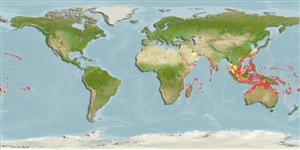Actinopterygii (ray-finned fishes) >
Perciformes (Perch-likes) >
Pomacanthidae (Angelfishes)
Etymology: Pomacanthus: Greek, poma, -atos = cover, operculum + Greek, akantha = thorn (Ref. 45335).
Environment / Climate / Range
Ecology
Marine; reef-associated; non-migratory; depth range 1 - 100 m (Ref. 48391). Tropical, preferred ?; 31°N - 28°S, 32°E - 144°W
Indo-Pacific: Red Sea and East Africa to the Hawaiian, Line and Tuamoto islands, north to southern Japan and the Ogasawara Islands, south to the Great Barrier Reef, New Caledonia, and the Austral Islands (Ref. 33390). Not found in Easter Island, Rapa and the Marquesan Islands (Ref. 48391).
Size / Weight / Age
Maturity: Lm ? range ? - ? cm
Max length : 40.0 cm SL male/unsexed; (Ref. 30573); max. reported age: 14 years (Ref. 72479)
Juveniles are encountered under ledges, or in holes of outer lagoon patch reefs or semi-protected areas of exposed channels and outer reef flats. Subadults move to reef front holes and surge channels. Large adults inhabit ledges and caves in areas of rich coral growth on clear lagoon, channel, or seaward reefs (Ref. 6113). Benthopelagic (Ref. 58302). Feed on sponges and other encrusting organisms (Ref. 6113); also on tunicates. Form pairs. Young and adults may clean much larger fishes such as sunfish (Ref. 48636). Frequently exported through the aquarium trade. Juveniles are distinguished by a white dorsal-fin margin (Ref. 48391).
Life cycle and mating behavior
Maturity | Reproduction | Spawning | Eggs | Fecundity | Larvae
Myers, R.F., 1991. Micronesian reef fishes. Second Ed. Coral Graphics, Barrigada, Guam. 298 p. (Ref. 1602)
IUCN Red List Status (Ref. 115185)
CITES (Ref. 94142)
Not Evaluated
Threat to humans
Harmless
Human uses
Fisheries: minor commercial; aquarium: commercial
More information
ReferencesAquacultureAquaculture profileStrainsGeneticsAllele frequenciesHeritabilityDiseasesProcessingMass conversion
Tools
Special reports
Download XML
Internet sources
Estimates of some properties based on models
Phylogenetic diversity index (Ref.
82805): PD
50 = 0.5001 [Uniqueness, from 0.5 = low to 2.0 = high].
Bayesian length-weight: a=0.03162 (0.01564 - 0.06394), b=2.91 (2.74 - 3.08), in cm Total Length, based on LWR estimates for this species & Genus-body shape (Ref.
93245).
Trophic Level (Ref.
69278): 2.7 ±0.00 se; Based on food items.
Resilience (Ref.
69278): Medium, minimum population doubling time 1.4 - 4.4 years (Preliminary K or Fecundity.).
Vulnerability (Ref.
59153): Moderate to high vulnerability (50 of 100) .
